
This site celebrates the life and work of sculptor John
Cassidy (1860 - 1939).
The town of Colwyn Bay, on the northern coast of Wales, is a product of the railway age, and the development of the great British seaside holiday. The station at Colwyn Bay was opened in 1848, and in 1865 the development of the place as a resort began. (The original settlement of Old Colwyn is nearby, higher on the hillside, and has a War memorial of its own.)
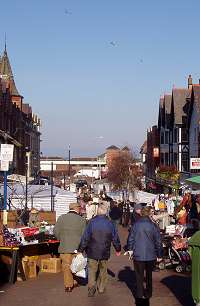
It is here that my interest in Cassidy intersects with the subject of my other website on the railways of North Wales, so an excuse for a visit there is always welcome.
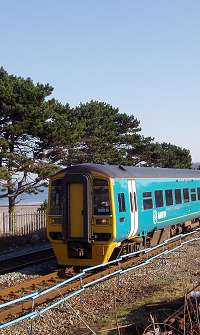
Today, Colwyn Bay still bustles and welcomes many visitors, although mostly day trippers rather than people on their annual holiday; increasingly the hotels are being replaced by residential accommodation.

The pier, a traditional feature of the British seaside resort, survives, under somewhat reduced circumstances; in 2008 it was owned by an individual whose efforts to restore it were hampered when he was made bankrupt for non-payment of charges to the local council.
Links
www.firstworldwar.com
UK National War Memorials Record ref.2230: Colwyn Bay
Colwyn Bay Roll of Honour
Colwyn Bay Civic Society
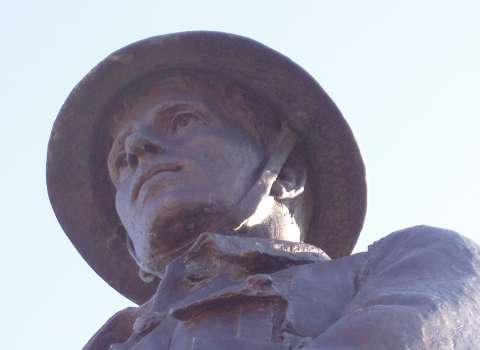
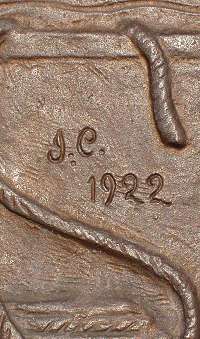
Colwyn Bay and District War Memorial
In March 1922 the Chairman (Simon Williams), the Treasurer
(D.Gamble) and the Treasurer (T.R. Roberts) of the War memorial
Committee issued a circular inviting inscriptions:
Dear
Sir (or Madam). It is now over three years since the Great War came to
an end, and up to the present there is nothing in the way of a Town
Memorial to commemorate the glorious sacrifice made by the men of this
district. The committee has for some time been appealing for
subscriptions in order that the proposed Memorial may be completed, but
so far only about £500 has been promised. The amount required for
the
memorial such as Colwyn Bay desires is at least £1000.
By September they wrote another letter to potential
subscribers:
The
Committee, having heard from the Sculptor that the Town Memorial to be
erected in the Council Ground will be ready for unveiling by November
1st, are anxious that every inhabitant should have an opportunity of
subscribing to the cost of same, so that it may be unveiled free of
dept. The amount still required is £300.
All was ready by Saturday November 11th 1922 and at 10.30 a.m.
on that day The Right Hon. Lord Colwyn unveiled the Memorial.
The Memorial was erected at the front of the original Town
Hall ...
when this was demolished in 1964, the Memorial was moved down the road
to Rydal Gardens, which have since been renamed Queen's Gardens.
It is an imposing statue and was sculpted by Mr. John Cassidy
of
Manchester. The engineer and surveyor was Mr W.J. Dunning from Colwyn
Bay Council and the bronze founders were H. H. Martyn & Co. Ltd.,
of Cheltenham. The foundation stone was fashioned by two monumental
masons, F. M. & H. Nuttall of Manchester and the local firm of
Davies & Son.
Of all the names on panels surrounding the base of the Memorial only one is a woman: Staff Nurse Catherine Williams Q.A.I.M.N.S: while in the book of remembrance produced for the unveiling ceremony the bronze figure of the soldier is described thus: 'In this figure there is no suggestion of the callousness or brutality associated with War. The Man is typical of the majority of the soldiers who comprised the armies of Great Britain during the Great War. Called from his uneventful civil pursuits by the stern voice of duty, he carries with him the refinement of his ordinary life, whilst the knowledge of the horrors and possibilities of War enhances his valour.'
'Desecrated'
From the North Wales Weekly News 4 Dec 2008 by Richard EvansColwyn Bay Town Council wants to install CCTV cameras to protect a war memorial that has been desecrated by vandals.
The memorial at Queen’s Gardens was recently sprayed with paint by yobs who also used the steps as a BMX run.
The bronze plate listing the names of soldiers lost in the First and Second World Wars and the Korean conflict was smeared with orange cellulose paint, while tyre marks have scarred the monument’s steps.
It is thought BMX bikers have used the steps on each of the four sides of the statue to perform stunts.
The damage was discovered at a special re-dedication ceremony at Queen’s Gardens just a couple of days before Remembrance Day, which marked a £20,000 makeover for the monument.
Town clerk John Roberts told a shocked chamber of councillors at the town hall last week how he discovered the mess.
'We had a re-dedication service which a fair few councillors attended. However, when we looked at the war memorial there were two slabs of stone badly in need of replacement,' he said.
'It wasn’t so apparent before they were cleaned but there were great holes in them. It had obviously been used as a BMX bike run. In addition to that someone had decided to spray orange paint on the back of one of the plaques.'
John Schofield is a member of Colwyn Bay’s Royal British Legion on Coed Pella Road and was shocked when he discovered the damage.
'The kids run riot in that park. It is all part of the national trend, nobody seems to be able to control them,' he said.
Colwyn Bay War Memorial, Conwy, Wales
An update, October 2009: see below
February 2008: a visit to Colwyn Bay

It was a sunny 16 February 2008 when I walked up from Colwyn
Bay railway station, through the town market, and turned right on to
the main Conway Road at the top, soon to get my first view of the War
Memorial, Queen's Gardens, and St John's Methodist
Church behind.
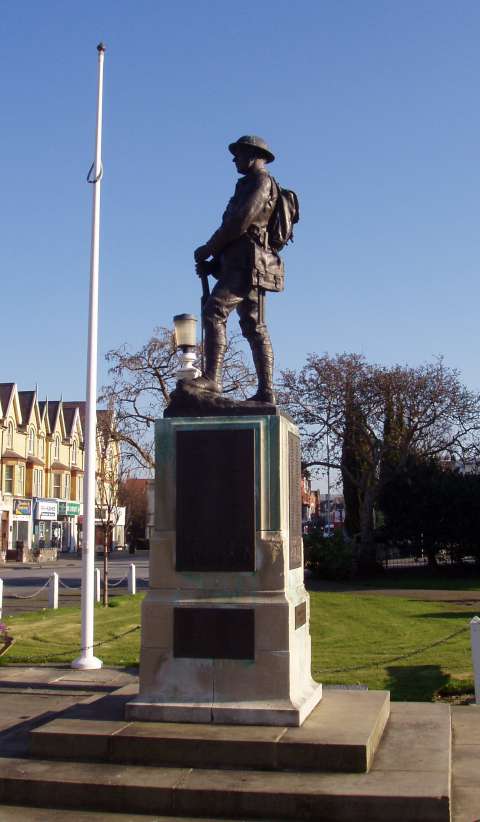
Lighting conditions were difficult due to the low winter sun shining on the back of the statue, but here it is, looking back towards the town. The plinth, which appears to be portland stone, is showing signs of deterioration, but the bronze statue and plaques are in good order.
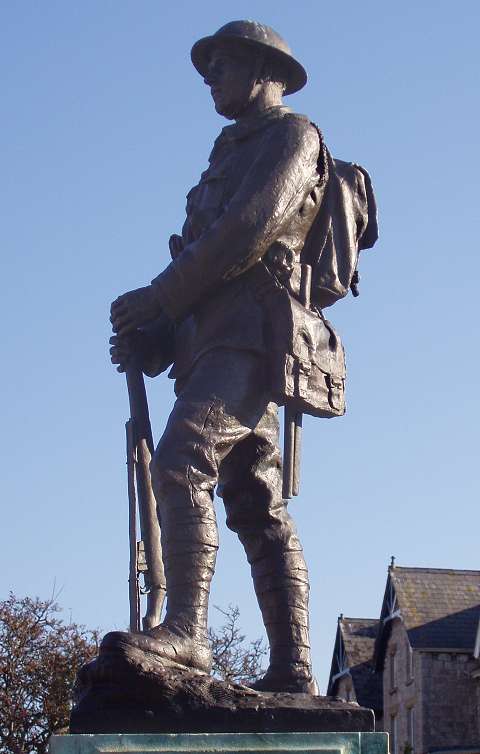
A close-up of Cassidy's British 'Tommy' with all his equipment
as carried through the unmentionable horror of the 1914-1918 trench
warfare.
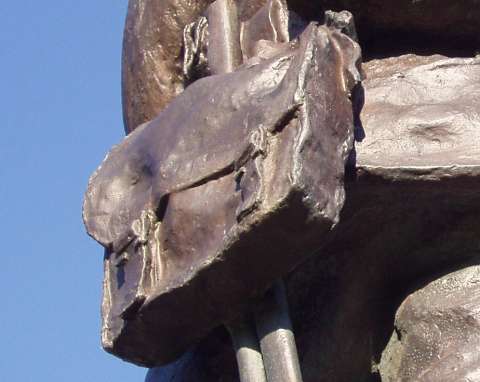
A close-up shows Cassidy's eye for detail; at the same time he
has left marks of his working of the original clay, to be replicated in
the final brionze casting, which somehow help to give a feeling of what
life was like in the mud of Flanders.

The face of bravery and dread.

The friezes incorporated into the plaques listing the names of
the dead are works of art in themselves: this one shows sailors on the
deck of a warship. This plaque is signed 'J.C. 1922' at the
right-hand end.

Here are soldiers marching to their next battle. The third
panel depicts returning servicemen and nurses, some wounded. The
plaques commemorate 174 dead from World War I; added after Cassidy's
death were additional plaques listing 38 from World War II and one from
the Korean War.
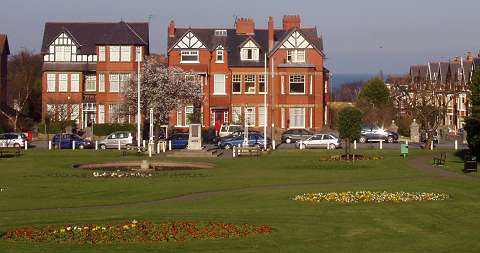
The soldier would have a view of the sea, if it wasn't
for the houses in between (as the old song has it).
History of the memorial
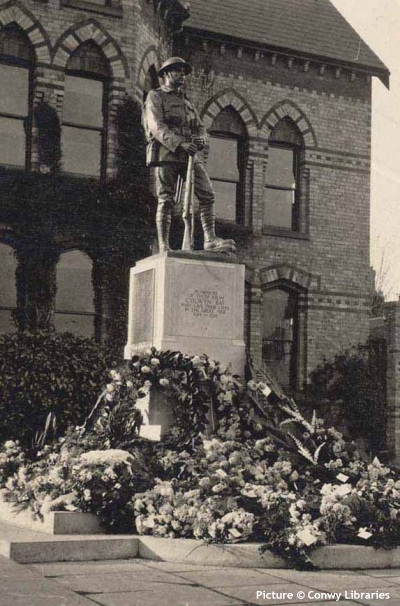
This picture shows the Memorial in its original position in
front of the old Town Hall. Thanks to Conwy
Libraries
staff, especially Neil Kewley of Llyfrgell Bae Colwyn (Colwyn Bay
Library)
for the historic picture and information.
The design of the memorial can be seen to follow that of
Cassidy's slightly earlier one of 1921 at Heaton
Moor.
Update, October 2009

These pictures, kindly supplied by Rachael Burke, show the memorial in 2009, having recently undergone restoration work.
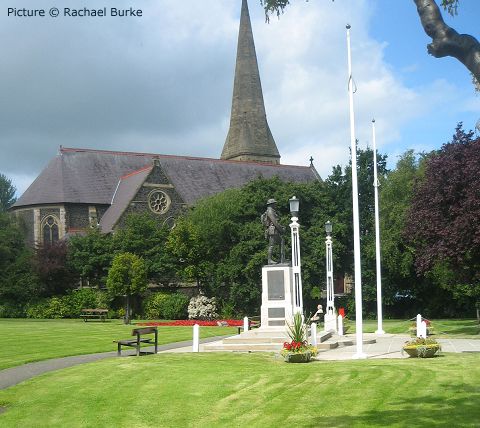
Page by Charlie Hulme - Last updated October 2009